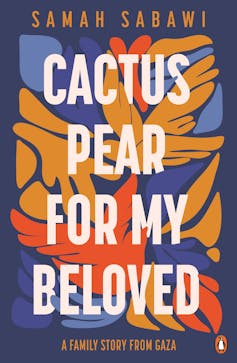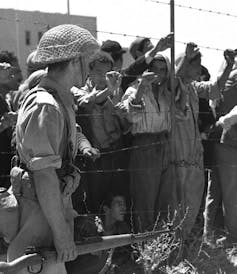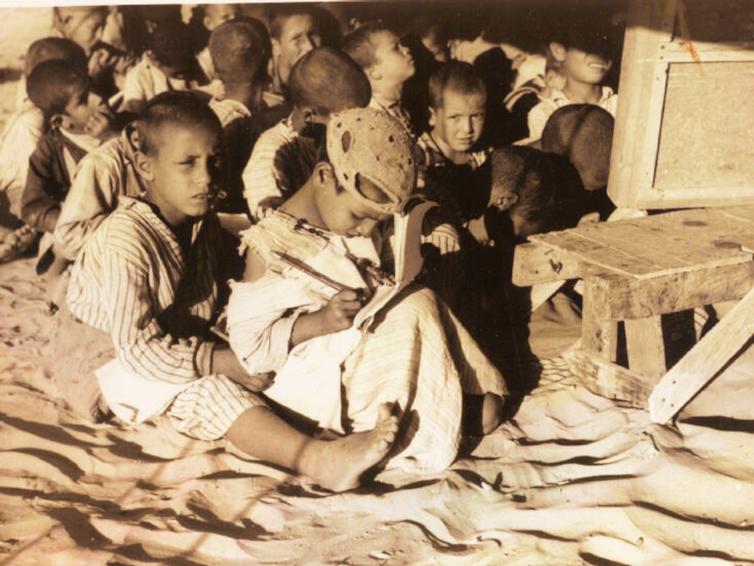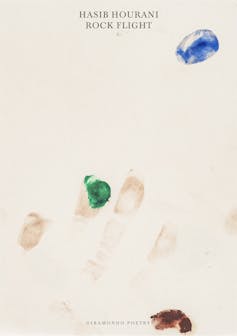By Michelle Hamadache, Macquarie University | –
(The Conversation) – While Hasib Hourani’s Rock Flight and Samah Sabawi’s Cactus Pear for My Beloved are both books by Australian writers that speak of the Palestinian experience, they could not be more different.
This is not simply because one is a book-length poem, the other a novelised biography. Hourani’s Rock Flight is minimalist, almost brutalist in its aesthetics. Cactus Pear for My Love, by contrast, is written with the detail and warmth of a storyteller who wants to commemorate a much-loved subject.
Review: Cactus Pear for My Beloved: A Family Story from Gaza – Samah Sawabi (Penguin) & Rock Flight – Hasib Hourani (Giramondo)
Sabawi tells the story of her father, Abdul Karim Sabawi, who died at the age of 82, shortly after the publication of her book. A renowned poet and novelist, Karim published more than ten novels and books of poetry in Arabic. His poetry was recently translated into English in a collection titled Blood for Freedom.
Sabawi recounts her father’s birth, his education and marriage, his work as a teacher and journalist, and his exile from Gaza after the Six-Day War of 1967 for his part in the Palestinian resistance.
She does this by fusing storytelling techniques with extensive ethnographic and historical research. Episodic in structure, Cactus Pear for My Beloved eschews explanations and psychologising. Rather, it relies on the vibrancy of its characters and the material details of their world to bring memorable moments to life.

Nahedh Elrayes, via Wikimedia Commons, CC BY-SA
Sabawi shares photos and artefacts, such as an image of her grandfather’s licence to run a small school from his home. Issued by The Government of Palestine, Department of Education, Jerusalem, it is dated 1935. At that time, Palestine was classed as a “Mandate A” territory and flagged by the League of Nations for independent nationhood.
Throughout Cactus Pear for My Beloved, Sabawi deftly connects personal stories to wider historical and political contexts. She also uses a number of novelistic techniques, such as fictional characters and dramatised scenes, to recreate the past and represent a collective Palestinian experience. These scenes alternate with historical accounts. The novelistic and biographical work together, producing a rich and often buoyant story.
Sabawi also records the importance of poets and the poetic tradition, both in her father’s schooling, and also in voicing the Palestinian experience under occupation. As a poet, Abdul Karim Sabawi’s life intersects with significant literary events, such as the 1964 Arab Poetry Festival in Gaza, and the conference of the Union of Palestinian Writers, where renowned writers such Ghassan Kanafani and Muin Bseiso were present.
Displacement and exile
Sabawi stops her father’s story in 1967, when her father was exiled. To stay would have risked arrest or death. Exile, in the words of her father, is not a journey, because “exile refuses to take me anywhere but exile itself”.
Though Cactus Pear for My Beloved takes place in the Tuffah quarter of Gaza City between 1918 and 1967, it is framed by a prologue and epilogue set in 2018 in a Queensland shopping mall, where Sabawi takes her now elderly father. This framing serves a number of purposes. It allows Sabawi to dramatise the spoken contract between father and daughter: he grants her permission to embark upon the project of telling her family’s history.
The shopping mall setting also underlines the distance and the differences between Karim’s old life in Palestine and his new life in Australia. It allows Sabawi to show her father’s humour and swagger in the face of old age. He prefers the shopping trolley to his walker, which makes him look old. The opening scene has him setting the terms. The finished manuscript must have his approval. He insists that his story be presented as “part of a tapestry of stories. If you pull it out of that tapestry it will unravel and will lose its meaning.”

True to her father’s instructions, Sabawi begins the story of her father, with the story of her grandfather Sheikh Hussein and his widowed mother Moftiya. An early scene takes place in the Sheikh’s house in 1918, the year the British occupied Palestine, and the year after the Balfour Declaration, which declared British “sympathy with Jewish Zionist aspirations”.
At the time, the area was 90% Arab and 10% Jewish. The Sheikh draws parallels between Palestine and India, telling the story of Gandhi’s resistance to British colonial forces to a room of men who can’t conceive of standing up against British military might.
The Sheikh is frustrated; his ability to access newspapers and keep up with the political situation makes him important, but it also isolates him. Only a train driver, who regularly travels outside of Tuffah, is able to conceive of the danger.
Thirty years later, the Sheikh will be fleeing his home with his family for the refugee camps during the Nakba of 1948, which displaced 750,000 Palestinians.
Sabawi uses dialogue to give voice to Palestinian experiences of the moment Britain left Palestine and the State of Israel was declared. The Sheikh, dumbfounded at the headlines in newspapers, cannot believe that the British handed over Palestine to European Jews:
They gave them everything. They gave them the official government buildings, the airports, the seaports, the military equipment and the training. Everything! And they gave us checkpoints, prison cells, torture chambers and targeted assassinations for any one of us who tries to resist.
Ultimately, the Sheikh is hopeful that times can’t be darker than they were under the Ottomans and the English. “You cannot empty a country of its people and claim it just like that. The world will soon see this”.

David Eldan/GPO, Public domain, via Wikimedia Commons
The family return home to Tuffah and the precarity of being native without being citizens. The Sheikh, who has been a teacher and leader of his community, is unable to flee when Israeli forces come to his home. In one powerful scene, he must declare himself crippled to avoid being shot. The humiliation is intensified by being witnessed by his son, who at the age of 14 must decide whether to intercede.
The book’s title is taken from the act of peeling cactus pears, which is the sensuous image of the love Sabawi’s father’s feels for her mother, Souhailah. The skin of the cactus pear is rife with thistles, so fine as to be invisible to the naked eye, yet lastingly painful to the hand they lodge in. But the fruit itself is wildly colourful, and much loved by Souhailah.
The gesture of peeling a cactus pear is intimate and devotional, rooted in Palestine and carried across continents to Australia. It spans Karim and Souhailah’s lifelong marriage, from their youthful courting to their old age.
Indeed, lust and love and a pragmatic attitude to sex play important roles in the book. Sabawi shows different forms of love to be organising forces in the lives of her characters: familial love, erotic love, love of friends, love of home, love of poetry and education, love of Gaza Beach, love of Palestine.
Sabawi describes the process of writing Cactus Pear for My Beloved as “bittersweet”. She recreates a past of “family, love and homeland”, while negotiating the “horrific trauma of dispossession and loss”. She depicts the experiences of people she loves and speaks of those experiences in a way that can be shared and remembered, viscerally, in the body and the heart.

Wikimedia Commons, CC BY-SA
How to make a rock
Rock Flight is first book of poetry by Lebanese-Palestinian writer Hasib Hourani. Though it can be read as a single book-length poem, its structure is fragmented. Intense lyrics are interspersed with records of torture techniques, footnotes and bureaucratic formatting, including redaction and multi-level lists.
Hourani, who was born in Bahrain and now lives in Sydney, demonstrates the visceral consequences of being Palestinian in a world that refuses to recognise the experience of occupation. He lays bare the violence of bureaucracy. By co-opting the typography of bureaucracy and scholarship, incorporating it into his poetry, he destabilises and challenges the markers of legitimacy and draws attention to structural violence.
Part of what makes Rock Flight so intense is that Hourani chooses a limited number of tropes – rocks, paper, suffocation, migratory birds – but overburdens them, so that there is an accumulative density to his poetry.
A close reading of the title demonstrates the density. Rocks are static until they are acted upon, so there is a tension in the coupling of “rock” with “flight”. But there is also the sonic and metrical aspect of the pairing: the sharp plosives (“f” and “t”) combining with the dead beat of a spondee. Then there are the contradictory connotations of “flight”. It sometimes suggests a motion that is graceful and soaring; sometimes it suggests fleeing. And it has an obvious rhyme: “fright”.
The title recalls that in the Israel-Palestine conflict, it has often been Palestinian rocks against Israeli tanks. It evokes the rubble of buildings hit by bombs. Yet rocks are also the pieces of a homeland that can be taken when one leaves. They represent the distinctive mythical and geological features of the territory.
In a deceptively simple section, How to Make a Rock, Hourani instructs the reader to crumple a piece of paper and throw it. A gesture of futility and frustration, paper is the symbol of the bureaucracy, but equally of the poem itself.
Poetics of the political
This kind of close attention is important, because Hourani’s poetics are indissolubly bound with the political, though not in the sense that he sacrifices poetry for a political message. He maintains a commitment to the way poetry works through image, form and sound. Poetry and politics fuse into a distinctive and significant aesthetic.
Poems deal directly with Boycott, Divestment and Sanctions against Israel. They detail the surveillance technology used to police Palestinians. They document torture techniques used by Israeli forces against Palestinian prisoners. All without losing the artistry and vision of the poet.

Rock Flight also deploys a poetics of motion and displacement. Its first gesture of is to root a family to a territory and a people to the land. The family name Hourani derives from the volcanic landscape of Houran, a region between Syria and Jordan. The title alludes to the connection to place and the migratory condition of so many Palestinians dispossessed or expelled.
Whether at a residency, or a return trip to Palestine, or in the midst of an exodus, the feeling of being in motion, uprooted, is captured through attention to the body. It is often conveyed through the experience of illness, from travel nausea to tonsillitis.
For instance, the book opens with the Hourani family in flight. The bile of travel sickness makes the poet’s throat “blister, then crunch, swallow, crunch”. The poem links this “suffocating state” to “the reason that I am elsewhere”.
The connection between swallowing and speech, stomach and sight, illness and the abject makes for visceral poetry. Even the birds are often abject or tragic. There are references to pelicans coated in an oil slick and the symbolic “pfeilstorch”, a migratory bird that flies across continents impaled by a spear.

Zoologische Sammlung der Universität Rostock, via Wikimedia Commons, CC BY-SA
Perhaps the most powerful refusal of Hourani’s poetry is the refusal to imagine a world beyond the complex of “it” – where “it” is not only Israel and Zionism, but surveillance technology, mainstream western media and the nations that directly and indirectly support the occupation of Palestine.
The poet may find himself elsewhere, but the complex is with him everywhere. The effect is claustrophobic. Politics, economics and body are enmeshed, experienced by and filtered through the politicised body of the poet.
The Palestinian people, whether those still living in occupied territories, or those who are refugees or migrants or children of the diaspora, are at the heart of Rock Flight, as they are in Sabawi’s Cactus Pear for My Beloved. Hourani and Sabawi are grouped together in a single review because the nation is such a powerful organising lens through which to interpret literature.
For many people, the national paradigm is a record of sites of invasion and occupation, lines drawn by colonial powers to legitimate claims over territories and resources, for the benefit of the powerful. Yet national identities are also the source of fierce loyalties and resistances that have allowed people to fight for independence or defend their homeland, to give their individual stories the weight and scale of a national story.
The number of Palestinian casualties since the present conflict began on October 7 2023 is conservatively estimated to be around 148,000. The number of people displaced from Gaza alone is nearly two million, or the population of Perth. What logic, what scale of values justifies this? How many Palestinian stories does it take for this to become wrong.
Michelle Hamadache, Director of Creative Writing, Macquarie University, Macquarie University
This article is republished from The Conversation under a Creative Commons license. Read the original article.
Featured image added by Informed Comment: “Refugees X,” Digital, Midjourney / Clip2Comic, 2024



 © 2025 All Rights Reserved
© 2025 All Rights Reserved